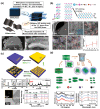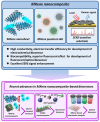Recent Advances in MXene Nanocomposite-Based Biosensors
- PMID: 33233574
- PMCID: PMC7699737
- DOI: 10.3390/bios10110185
Recent Advances in MXene Nanocomposite-Based Biosensors
Abstract
The development of advanced biosensors with high sensitivity and selectivity is one of the most demanded concerns in the field of biosensors. To meet this requirement, up until now, numerous nanomaterials have been introduced to develop biosensors for achieving high sensitivity and selectivity. Among the latest nanomaterials attracting attention, MXene is one of the best materials for the development of biosensors because of its various superior properties. MXenes are two-dimensional inorganic compounds with few atomic layers that possess excellent characteristics including high conductivity and superior fluorescent, optical, and plasmonic properties. In this review, advanced biosensors developed on the basis of the MXene nanocomposite are discussed with the selective overview of recently reported studies. For this, introduction of the MXene including the definition, synthesis methods, and its properties are discussed. Next, MXene-based electrochemical biosensors and MXene-based fluorescent/optical biosensors are provided, which are developed on the basis of the exceptional properties of the MXene nanocomposite. This review will suggest the direction for use of the Mxene nanocomposite to develop advanced biosensors with high sensitivity and selectivity.
Keywords: MXenes; biosensors; electrochemical biosensor; fluorescent/optical biosensor; high sensitivity/selectivity; nanomaterials.
Conflict of interest statement
The authors declare no conflict of interest.
Figures




Similar articles
-
Recent Advancements in MXene-Based Biosensors for Health and Environmental Applications-A Review.Biosensors (Basel). 2024 Oct 12;14(10):497. doi: 10.3390/bios14100497. Biosensors (Basel). 2024. PMID: 39451710 Free PMC article. Review.
-
Electrochemical and optical biosensors based on multifunctional MXene nanoplatforms: Progress and prospects.Talanta. 2021 Dec 1;235:122726. doi: 10.1016/j.talanta.2021.122726. Epub 2021 Jul 21. Talanta. 2021. PMID: 34517594 Review.
-
Biomedical Applications of an Ultra-Sensitive Surface Plasmon Resonance Biosensor Based on Smart MXene Quantum Dots (SMQDs).Biosensors (Basel). 2022 Sep 9;12(9):743. doi: 10.3390/bios12090743. Biosensors (Basel). 2022. PMID: 36140128 Free PMC article. Review.
-
Emerging trends and recent advances in MXene/MXene-based nanocomposites toward electrochemiluminescence sensing and biosensing.Biosens Bioelectron. 2024 Dec 1;265:116623. doi: 10.1016/j.bios.2024.116623. Epub 2024 Aug 2. Biosens Bioelectron. 2024. PMID: 39178717 Review.
-
MXene-Based Electrochemical Biosensors: Advancing Detection Strategies for Biosensing (2020-2024).Biosensors (Basel). 2025 Feb 20;15(3):127. doi: 10.3390/bios15030127. Biosensors (Basel). 2025. PMID: 40136924 Free PMC article. Review.
Cited by
-
MXene-Based Nucleic Acid Biosensors for Agricultural and Food Systems.Biosensors (Basel). 2022 Nov 7;12(11):982. doi: 10.3390/bios12110982. Biosensors (Basel). 2022. PMID: 36354491 Free PMC article. Review.
-
Colorimetric and photothermal dual-mode immunosensor based on Ti3C2Tx/AuNPs nanocomposite with enhanced peroxidase-like activity for ultrasensitive detection of zearalenone in cereals.Mikrochim Acta. 2023 Nov 23;190(12):479. doi: 10.1007/s00604-023-06073-7. Mikrochim Acta. 2023. PMID: 37994918
-
The Rise of MXene: A Wonder 2D Material, from Its Synthesis and Properties to Its Versatile Applications-A Comprehensive Review.Top Curr Chem (Cham). 2023 Mar 13;381(2):11. doi: 10.1007/s41061-023-00420-1. Top Curr Chem (Cham). 2023. PMID: 36907974 Review.
-
Improving Biosensors by the Use of Different Nanomaterials: Case Study with Microcystins as Target Analytes.Biosensors (Basel). 2021 Dec 20;11(12):525. doi: 10.3390/bios11120525. Biosensors (Basel). 2021. PMID: 34940282 Free PMC article. Review.
-
Development of Two-Dimensional Functional Nanomaterials for Biosensor Applications: Opportunities, Challenges, and Future Prospects.Nanomaterials (Basel). 2023 Apr 29;13(9):1520. doi: 10.3390/nano13091520. Nanomaterials (Basel). 2023. PMID: 37177065 Free PMC article. Review.
References
-
- Roointan A., Mir T.A., Wani S.I., Mati-ur-Rehman, Hussain K.K., Ahmed B., Abrahim S., Savardashtaki A., Gandomani G., Gandomani M., et al. Early detection of lung cancer biomarkers through biosensor technology: A review. J. Pharm. Biomed. Anal. 2019;164:93–103. doi: 10.1016/j.jpba.2018.10.017. - DOI - PubMed
Publication types
MeSH terms
Substances
Grants and funding
LinkOut - more resources
Full Text Sources

